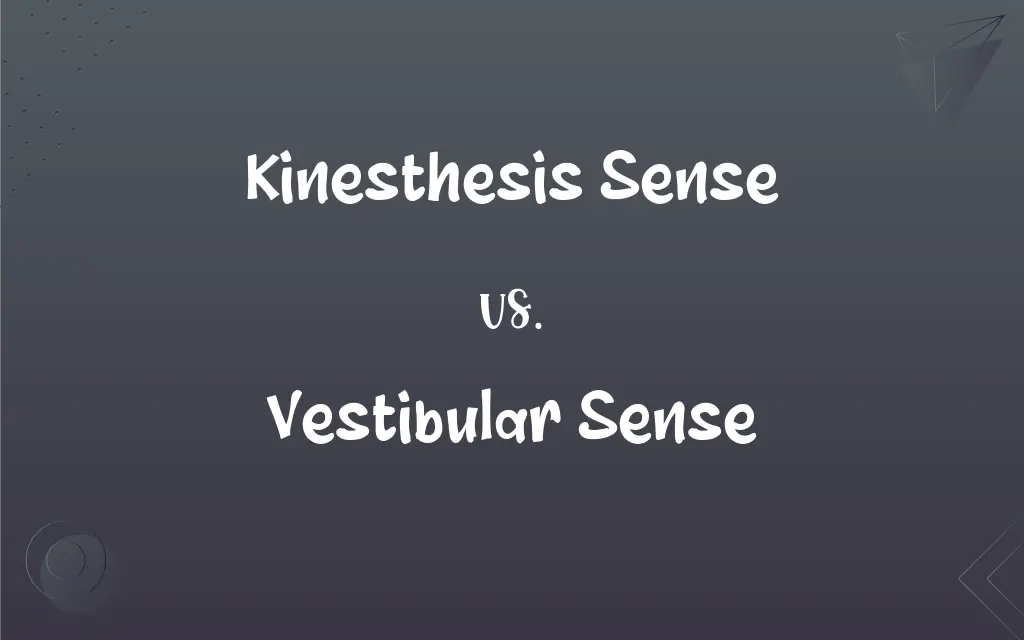Kinesthesis Sense vs. Vestibular Sense: What's the Difference?
Edited by Aimie Carlson || By Janet White || Published on February 21, 2024
Kinesthesis sense involves sensing body movements and position, while the vestibular sense maintains balance and spatial orientation.

Key Differences
The kinesthetic sense, also known as proprioception, is the sense that detects bodily position, weight, or movement of the muscles, tendons, and joints. It enables awareness of the position and movement of parts of the body without seeing them. In contrast, the vestibular sense is focused on balance and spatial orientation. It arises from the inner ear and provides sensory information about motion, equilibrium, and spatial orientation.
Kinesthetic sense relies on receptors in muscles, tendons, and joints to provide information about body position and movement. This sensory input helps coordinate motion and maintain posture. The vestibular sense, on the other hand, uses the vestibular system located in the inner ear, including the semicircular canals and otolith organs, to detect changes in head position and motion, thus aiding in balance and orientation.
The kinesthetic sense plays a crucial role in activities requiring precise movements, such as playing a musical instrument or typing, where the position and movement of the fingers need to be precisely coordinated. The vestibular sense is crucial for maintaining balance while standing, walking, or any activity involving changes in position or direction, like driving or sailing.
Kinesthetic sense is vital for motor skill development and learning new physical activities, as it helps in understanding and repeating movements. The vestibular sense is essential for developing balance and spatial awareness, important in early childhood for activities like crawling and walking, and in adults for activities that involve changes in speed or direction.
Impairments in kinesthetic sense can lead to difficulties in movement coordination and fine motor skills, affecting daily activities and physical tasks. Vestibular sense impairments can result in problems with balance and spatial orientation, leading to symptoms like dizziness, vertigo, and difficulty navigating spaces.
ADVERTISEMENT
Comparison Chart
Function
Detects body position and movement
Maintains balance and spatial orientation
Sensory Information
From muscles, tendons, joints
From the inner ear (semicircular canals, otoliths)
Role in Activities
Coordination of precise movements
Balance during movement and changes in position
Developmental Importance
Motor skill development and learning
Balance and spatial awareness in movement
Disorders
Affect movement coordination, fine motor skills
Lead to dizziness, vertigo, balance issues
ADVERTISEMENT
Kinesthesis Sense and Vestibular Sense Definitions
Kinesthesis Sense
Detecting physical position and movements internally.
Dancers use kinesthetic sense to maintain coordination during performances.
Vestibular Sense
Detecting changes in head position and motion.
The vestibular sense allows dancers to keep balance during quick turns.
Kinesthesis Sense
Coordination of body movements through internal sensors.
He uses his kinesthetic sense to type quickly without errors.
Vestibular Sense
Maintaining balance and spatial orientation.
Her vestibular sense keeps her steady while walking on a balance beam.
Kinesthesis Sense
Awareness of muscle, tendon, and joint motion.
A gymnast relies on her kinesthetic sense for complex routines.
Vestibular Sense
Sensing motion and equilibrium via the inner ear.
Pilots rely on their vestibular sense to navigate planes through turbulent skies.
Kinesthesis Sense
Internal sense guiding physical movement and posture.
She trusts her kinesthetic sense to guide her movements in yoga poses.
Vestibular Sense
Orientation in space and gravitational forces.
His vestibular sense helps him not to get dizzy while doing flips as a diver.
Kinesthesis Sense
Sensing body part movement and position.
His kinesthetic sense helps him to play the piano without looking at the keys.
Vestibular Sense
Inner ear system regulating balance and movement.
She uses her vestibular sense to stay upright while surfing.
FAQs
What is kinesthetic sense?
It's the sense of body position and movement.
Where is the vestibular system located?
In the inner ear.
What does the vestibular sense do?
It maintains balance and spatial orientation.
How does kinesthetic sense help in sports?
It coordinates body movements and balance.
Why is the vestibular sense important for pilots?
It helps them perceive motion and maintain equilibrium.
How does aging affect the vestibular sense?
It can lead to a decline in balance and spatial orientation.
Can kinesthetic sense be improved?
Yes, through practice and physical training.
How do you test vestibular function?
Through specialized balance and hearing tests.
Is kinesthetic sense innate or learned?
It's a combination of both innate ability and learned skills.
What role does kinesthetic sense play in learning?
It aids in acquiring and refining motor skills.
Where are kinesthetic sensors located?
In muscles, tendons, and joints.
What activities rely heavily on kinesthetic sense?
Dancing, gymnastics, and playing musical instruments.
What disorders affect the vestibular sense?
Vertigo, balance disorders, and motion sickness.
Can vestibular sense be impaired without ear problems?
Yes, as it can be affected by neurological issues.
Are there exercises to enhance vestibular function?
Yes, balance and eye movement exercises can help.
Is kinesthetic sense important for everyday activities?
Yes, for actions like walking, writing, and using tools.
Does everyone have a developed vestibular sense?
Most do, but its effectiveness can vary.
Can vestibular disorders be treated?
Yes, with therapy, medication, or surgery depending on the cause.
How does kinesthetic sense differ from touch?
Kinesthetic sense is internal body awareness, while touch is external.
What impacts kinesthetic perception accuracy?
Physical fitness, awareness, and neurological health.
About Author
Written by
Janet WhiteJanet White has been an esteemed writer and blogger for Difference Wiki. Holding a Master's degree in Science and Medical Journalism from the prestigious Boston University, she has consistently demonstrated her expertise and passion for her field. When she's not immersed in her work, Janet relishes her time exercising, delving into a good book, and cherishing moments with friends and family.
Edited by
Aimie CarlsonAimie Carlson, holding a master's degree in English literature, is a fervent English language enthusiast. She lends her writing talents to Difference Wiki, a prominent website that specializes in comparisons, offering readers insightful analyses that both captivate and inform.






































































